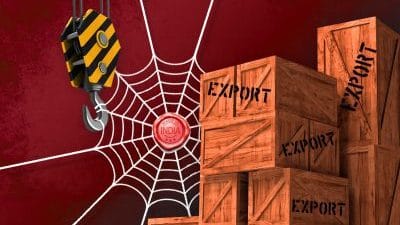The second coming of Donald Trump seems to be upending the Narendra Modi government’s decade-long policy of increased protectionism. And this is a good thing.
In all the brouhaha over tariffs, something important is being lost: it is in our national interest.
India needs to lower its import tariffs, not because we fear reciprocal tariffs, but so that Indian corporate behemoths can test themselves against global competition and consumers can benefit from increased choice and lower prices.
Import tariffs, in any case, are not an economic consideration for the government of India, with data from the Budget showing that customs duty isn’t a key revenue source. Tariffs certainly are a strategic tool, such as when used to curb Chinese imports, but they aren’t really working there, either. Furthermore, non-tariff measures are more effective if such strategic concerns loom large.
Apart from the economic and strategic considerations, there’s the optics. High import tariffs don’t align with Vishwaguru or ‘leader of the Global South’ ambitions. In other words, it’s much harder to extend a hand of friendship when high walls stand in your way.
Some of the import duties don’t make sense, either. For example, India charges a customs duty of Rs 100 per kg on imported almonds. This must be to protect our robust domestic cultivation of almonds, right? Well, India produced about 4,200 tonnes of almonds in the marketing year 2023-24, while it imported 2.6 lakh tonnes. Domestic almond production is about 1.6 percent of imports.
Aha, so this must be a revenue thing, you might argue. If India imports so much of various goods, it makes sense from a money-making perspective to impose tariffs on these items. Surely the customs duty is a vital pillar of Indian government finances. Not really.
The Union Budget 2025-2026, presented earlier this month, shows that import duties have grown at less than 2 percent per year on average between 2014-15 and what’s budgeted for 2025-26. What’s more, India’s total import duty collections are budgeted to make up just 8 percent of total tax revenues in 2025-26, down substantially from around 20 percent in 2014-15.
The reason for this is clear: other tax sources—especially income tax—have grown far faster. But the conclusion remains the same: import duties are not a significant source of revenue, and keeping them high isn’t a fiscally motivated decision.
Also read: Trump has called Delhi a big abuser of tariffs. India-US economic ties are about to change
Tariffs aren’t a jingoistic weapon
That brings us to the strategic aspect. It is, of course, important to protect India from the flood of Chinese products that have already been coming in and will increasingly arrive once Trump’s higher tariffs on that country come into effect. China has significant overcapacity and will look to other large markets.
There are several issues here. The first is that, despite India’s relatively high tariffs, which are currently at about 12 percent on a weighted average basis, imports from China have only grown. The cost differential between Chinese imports and Indian-made items is just too great a factor, even with tariffs.
The second issue concerns who actually pays the tariffs. There seems to be a general perception that if we hike tariffs on Chinese goods, we are somehow imposing a cost on China. This, of course, is incorrect. Tariffs are no jingoistic weapon against an external enemy.
It is the importers that pay the customs duties, not the exporters. That is, Indian companies—in large part small and medium-sized—are the ones that bear the cost of higher tariffs, not the Chinese exporters.
This ties into the third aspect of this issue, which is that, if India does want to limit Chinese imports, non-tariff measures are more effective and impose a lower cost.
For example, India has mandated that solar energy companies that want to benefit from government schemes and incentives must source their modules from an ‘approved list’ of suppliers. You can be sure this approved list only contains Indian names. The government is all set to do the same for solar cells.
Similarly, the government issued an order last year mandating that solar water heaters sold in India must carry a Bureau of Indian Standards (BIS) certification. Again, you can be sure Chinese imports are not going to receive this certification.
Over the last few years, the government has issued several other such quality control orders. These not only benefit customers, who are protected from substandard products, but also don’t impose any additional cost on Indian importers while still curbing imports.
To be sure, India needs to be careful with such orders. Domestic production of these items needs to quickly catch up with demand, failing which, the only thing such orders will do is deprive Indian consumers of that particular product.
Finally, if the government does choose the tariff route, it has the option of levying targeted and sector-wise tariffs against China, such as in the form of anti-dumping duties. But these should generally be avoided.
The true way Indian companies can eventually become self-sufficient is by being thrown into the global deep end, rather than being coddled in the kiddy pool of domestic markets and high tariffs.
Pick any of this government’s taglines—Viksit Bharat, Vishwa Guru, Vishwa Mitra, Atma Nirbhar, Sabka Saath—and you’ll find each one will benefit from a lowering of import duties. And we have Donald Trump to thank for that.
TCA Sharad Raghavan is Deputy Editor – Economy at ThePrint. He tweets @SharadRaghavan. Views are personal.
(Edited by Prashant)







Wholeheartedly agree with your views which I have for long supported that India must lower tariffs and move to a more market friendly policies. We need to start by dramatically reducing the size of our bureaucracy who will neither let you to simplify regulations nor allow any meaningful reforms.
Well articulated. Indian manufacturers need support but not mollycoddling.
The protectionist decade has harmed manufacturing, exports, job creation. Economists of the caliber of Dr Arvind Panagariya in Niti Aayog should have flagged issues early on.